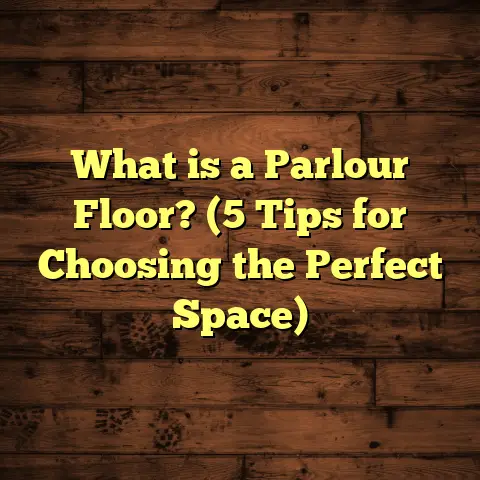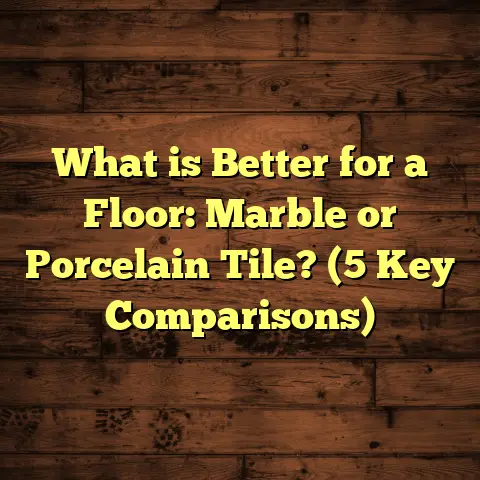What is the Average Cost to Install Laminate Flooring? (5 Factors to Consider)
I remember the first time I decided to install laminate flooring in my living room. I was excited about giving the space a fresh look without spending a fortune. But soon, I realized that understanding the cost involved was trickier than I expected. So, if you’re thinking about laminate flooring and wondering how much it might set you back, let me walk you through what I’ve learned from my projects, experiences, and research over the years.
What is the Average Cost to Install Laminate Flooring?
Laminate flooring is a type of synthetic flooring product designed to replicate the appearance of real wood or stone at a more affordable price. It consists of several layers: a durable wear layer on top, a photographic layer that gives it its distinctive look, a core layer made from high-density fiberboard (HDF) or medium-density fiberboard (MDF), and a backing layer for stability and moisture resistance.
Installing laminate flooring involves placing these planks over a prepared subfloor, often with an underlayment beneath to improve comfort, reduce noise, and help with moisture control.
Based on my experience handling multiple projects across residential spaces, the average cost to install laminate flooring typically ranges between $3 and $8 per square foot. This figure includes both materials and labor but can swing higher or lower depending on the variables involved.
For example, during one project in my own home office, I paid about $5 per square foot for mid-range laminate with professional installation. It gave me a great balance between durability, aesthetics, and cost.
Why Laminate Flooring?
You might wonder why laminate flooring has become such a popular choice. From what I’ve seen firsthand and heard from clients, it offers:
- Cost-effectiveness: Laminate tends to cost less than hardwood or stone.
- Durability: It resists scratches and dents better than many natural materials.
- Style variety: You can find designs mimicking everything from oak to slate.
- Ease of maintenance: Cleaning laminate is usually just sweeping or damp mopping.
- Relatively easy installation: Many planks use click-lock systems that speed up installation.
Laminate flooring isn’t perfect — it’s not as long-lasting as real hardwood and can swell if exposed to excessive moisture — but for many homeowners, its benefits outweigh those drawbacks.
5 Factors That Affect Laminate Flooring Installation Costs
I’ve installed or overseen dozens of laminate flooring projects and noticed that five main factors tend to cause cost differences. Let’s break each one down:
1. Material Quality and Type
Not all laminate flooring planks are created equal. The quality of the material you choose has a huge impact on price.
- Entry-level laminate costs around $1 to $2 per square foot. These planks are thinner, with less durable wear layers. They might look fine initially but tend to wear faster over time.
- Mid-range laminate usually falls between $2 and $4 per square foot. This category features thicker boards with better wear layers and more realistic textures.
- High-end laminate can go upwards of $5 per square foot or more. These often include water-resistant technologies, enhanced embossing, and thicker construction for longer life.
I recall early in my career selecting entry-level laminate for a rental property to save money upfront. The floors looked decent but started showing wear within two years. For my family home’s kitchen remodel later on, I chose a high-end water-resistant laminate priced at about $6 per square foot. It still looks great after three years despite heavy use.
The brand also matters — well-known brands tend to charge more but offer warranties and consistent quality.
2. Room Size and Layout Complexity
The size and shape of the room influence costs beyond just how many square feet you cover.
- Larger rooms benefit from economies of scale—there’s less waste relative to total area.
- Irregular layouts with many corners, doorways, closets, or built-ins require more cuts and fitting time.
- Hallways or narrow spaces often increase labor intensity due to precision cutting.
A good example comes from one of my jobs where I installed laminate in a simple rectangular living room. The installer finished quickly, keeping labor costs low. However, another project in an older house had a hallway with multiple doorways and odd angles; this added around 15% extra labor due to the intricate cuts required.
Additionally, stairs or elevated areas add complexity if you want matching laminate stair treads or risers.
3. Subfloor Preparation
A smooth, level subfloor is essential for proper laminate installation. Subfloor condition impacts both cost and final results.
- If your subfloor is clean, flat, and free of damage, installation proceeds quickly.
- Uneven floors may require leveling compounds or repairs.
- Removing old flooring like carpet or vinyl can add labor.
- Moisture barriers may be needed in basements or damp areas.
Once I took on a project where the subfloor had major uneven spots. We had to use self-leveling compound over two days before laying laminate. That prep added roughly $1-$2 per square foot on top of material and labor.
Skipping subfloor work leads to squeaks, uneven wear, or damaged laminate down the road—something I always insist clients avoid despite the added upfront cost.
4. Labor Costs in Your Area
Labor rates vary widely depending on your location’s market conditions.
- Urban areas with higher living costs often have installers charging $3-$4 per square foot.
- Rural or less expensive regions might have rates closer to $1.50-$2.50 per square foot.
- Some contractors include removal of old flooring; others charge separately.
In my experience working in multiple states, labor often makes up about 40-50% of total laminate floor costs.
Using tools like FloorTally helps me get accurate local labor rate estimates when planning projects in unfamiliar areas. This tool gathers data on both material prices and labor rates based on zip codes—saving me time and giving clients realistic budgets.
5. Additional Materials and Waste Factor
Besides the planks themselves, several other materials are needed:
- Underlayment: Provides cushioning & soundproofing; typically $0.20-$0.50/sq ft.
- Transition strips: Needed where laminate meets other flooring types.
- Moldings/baseboards: To finish edges neatly.
- Adhesives or moisture barriers if required.
Also factor in about 5-10% extra material for waste due to cutting errors or pattern matching.
Years ago, I made the mistake of ordering exactly what the room measured—no extra allowance—and had to pause mid-project to buy more planks. Since then, I always budget extra material upfront.
Detailed Case Studies from My Projects
To give you a clearer picture of real costs and challenges, here are some case studies from various installations I’ve managed:
Case Study 1: Mid-Sized Living Room Remodel
- Size: 350 sq ft
- Material: Mid-range laminate at $3/sq ft
- Labor cost: $2/sq ft
- Subfloor: Clean plywood, no prep needed
- Additional Materials: Underlayment + trims: $0.50/sq ft
- Waste factor: 7%
Total material cost:
$3 x 350 = $1,050
Underlayment + trims = $175
Waste (7% extra material): 350 x .07 = 24.5 sq ft → 25 sq ft x $3 = $75
Total materials: $1,300
Labor cost:
$2 x 350 = $700
Grand total: $2,000
The project took two days with no major issues. The client was happy with the price-quality ratio.
Case Study 2: Large Family Room With Complex Layout
- Size: 600 sq ft
- Material: High-end water-resistant laminate at $5/sq ft
- Labor cost: $3/sq ft (due to complexity)
- Subfloor: Uneven concrete requiring leveling ($1.50/sq ft)
- Additional Materials: Underlayment + transitions + moldings = $0.70/sq ft
- Waste factor: 10%
Material cost:
$5 x 600 = $3,000
Underlayment + extras = $420
Waste (10%): 60 sq ft x $5 = $300
Total materials: $3,720
Labor cost:
$3 x 600 = $1,800
Subfloor prep:
$1.50 x 600 = $900
Grand total: $6,420
This project took almost a week due to subfloor prep and layout complexities but resulted in a stunning floor that’s held up well after two years.
Case Study 3: Small Kitchen Installation
- Size: 150 sq ft
- Material: Entry-level laminate at $2/sq ft
- Labor cost: $2.50/sq ft (tight space)
- Subfloor: Needed minor repairs ($0.75/sq ft)
- Additional Materials: Underlayment + trims: $0.40/sq ft
- Waste factor: 5%
Material cost:
$2 x 150 = $300
Underlayment + trims: $60
Waste (5%): 7.5 sq ft x $2 = $15
Total materials: $375
Labor cost:
$2.50 x 150 = $375
Subfloor prep:
$0.75 x 150 = $112
Grand total: $862
Small spaces often have higher labor costs because installers must work around cabinets and appliances carefully.
How Tools Like FloorTally Help Me Plan Flooring Projects
Estimating flooring costs accurately is critical for staying within budget and avoiding surprises later on. Early in my career, I relied heavily on spreadsheets and manual calculations — which sometimes led to mistakes or overlooked expenses.
Now I use FloorTally regularly for several reasons:
- Local Price Accuracy: It pulls local labor rates and material prices based on your zip code.
- Waste Factor Integration: Automatically adds waste percentages so you don’t underestimate needed materials.
- Breakdown Views: Separates material costs from labor and additional supplies for clear budgeting.
- Customization: Lets me select from various material qualities and underlayment options.
- Time-saving: Instead of calling multiple suppliers or installers for quotes, FloorTally gives fast ballpark figures that I can refine later.
For example, when preparing a bid for a client’s basement renovation last year, FloorTally provided an estimate within 5% accuracy compared to actual costs — saving us time and building trust with the client early on.
Common Questions About Laminate Flooring Costs
Here are some questions I often get asked:
How long does laminate flooring last?
With proper care, good-quality laminate can last between 15 to 25 years. Lower-end options might wear out sooner. I’ve had clients report their floors still look great after more than a decade.
Is DIY installation cheaper?
Yes — you save on labor costs which often make up half the budget. But DIY requires patience and skill with cutting planks precisely and prepping subfloors correctly. Mistakes can lead to wasted materials or uneven floors.
Can laminate be installed over existing flooring?
Usually yes — if the existing floor is flat and stable (like vinyl or tile). Carpets need removal first. I always check subfloor conditions before proceeding.
What about moisture damage risks?
Standard laminate isn’t waterproof but water-resistant varieties have improved dramatically in recent years. Still, avoid standing water or very humid areas unless you use specialized products.
Personal Tips From My Experience
I want to share some practical insights from years installing laminate flooring:
- Always order extra planks upfront — better safe than sorry.
- Don’t skimp on subfloor prep; it’s the foundation of a good floor.
- Compare multiple installer quotes but check references carefully.
- Choose an underlayment suited for your needs (soundproofing vs moisture barrier).
- Consider future needs — if resale value matters, mid-to-high range options pay off long term.
- Take care during installation not to damage edges; damaged planks can ruin entire rows.
- Keep room temperature steady during installation — extreme cold/hot affects plank expansion/contraction.
When I follow these guidelines myself or advise clients, projects run smoother with fewer callbacks.
Breaking Down Costs in Detail: What You’re Paying For
Let’s look at what exactly makes up your laminate flooring costs:
| Cost Component | Typical Range ($/sq ft) | Description |
|---|---|---|
| Laminate Planks | 1 – 6+ | Depends on quality & brand |
| Underlayment | 0.20 – 0.50 | Foam or cork padding under floor |
| Moldings & Transitions | 0.30 – 1+ | Finishing edges & connecting rooms |
| Subfloor Prep | 0 – 2+ | Repairs/leveling as needed |
| Labor | 1.50 – 4+ | Varies by region & complexity |
| Waste Allowance | ~5 – 10% extra | Extra planks for cuts/errors |
Breaking it down like this helped me explain budgets clearly when consulting for clients who didn’t understand why “materials” alone weren’t enough.
Trends Affecting Laminate Flooring Costs Today
Over recent years I’ve noticed some trends impacting prices:
- Rising raw material costs: Fiberboard prices have increased due to supply chain issues.
- Improved water resistance: New laminates with enhanced moisture protection tend to be pricier but worth it for kitchens/bathrooms.
- Eco-friendly options: Some brands now offer recycled content or low-VOC finishes which add slight premiums.
- Labor shortages: In some markets, skilled installers are harder to find causing labor rates to rise.
Staying aware of these helped me adjust bids realistically rather than promise too low or too high estimates.
Wrapping Up My Thoughts on Laminate Flooring Costs
If you’re reading this because you want durable floors that look good without emptying your wallet, laminate offers solid value when chosen right.
From my journey starting with budget basics through mastering complex installs with premium products, the key lesson is clear: planning matters most.
Think about quality needs first — cheap planks save money today but could cost more replacing sooner.
Factor in your room’s layout carefully — complex shapes increase labor time and waste.
Don’t underestimate subfloor prep — it makes all the difference in floor longevity.
Use tools like FloorTally or consult local pros for accurate estimates tailored to your location so your budget fits reality instead of guesswork.
At the end of the day, asking questions and knowing what impacts cost helps you make decisions confidently — whether DIYing or hiring pros.
I hope sharing my experience helps you feel better prepared for your laminate flooring project!
Got questions about your specific job? Or want tips on picking products? Just ask—I’m here to help!





